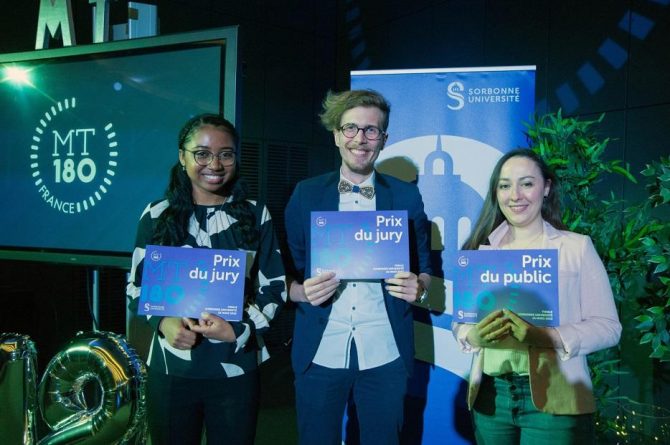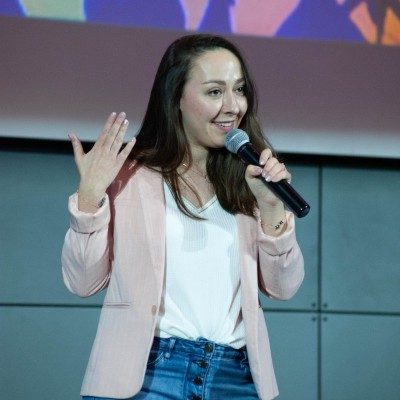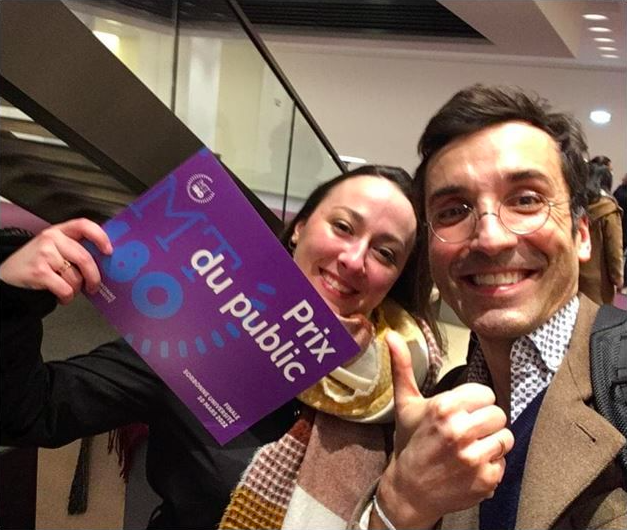 Louison Lallemant is a doctoral student in the group of Mario Gomes-Pereira and Geneviève Gourdon within the REDs team led by Denis Furling and Geneviève Gourdon, at the Institute’s Myology Centre for Research. She has just won the Public Prize awarded by Internet users and the public attending the Sorbonne University Final of the “My thesis in 180 seconds”* competition.
Louison Lallemant is a doctoral student in the group of Mario Gomes-Pereira and Geneviève Gourdon within the REDs team led by Denis Furling and Geneviève Gourdon, at the Institute’s Myology Centre for Research. She has just won the Public Prize awarded by Internet users and the public attending the Sorbonne University Final of the “My thesis in 180 seconds”* competition.
Why did you want to take part in this competition?
L L: I’m interested in scientific mediation and this competition gives me additional experience. I was able to observe on several occasions that the non-specialist people to whom I was able to talk about neurons and research were very enthusiastic… I had already presented my thesis subject to high school students during the “Déclics”** days. and I had very good feedback from them. Participating in this competition also allowed me to highlight myotonic dystrophy which is a rare disease and little known to the general public. Finally, there was also, of course, the personal challenge of presenting 3 years of research in 3 minutes…
M G-P: This French-speaking competition highlights the work of doctoral students and young doctors from all disciplines with subjects on the physics of black holes, literature, history, music and, of course, life sciences…

What is the subject of your talk?
LL: I work on Myotonic Dystrophy type 1 (DM1), a rare neuromuscular disease which is due to a genetic mutation studied for several decades for its consequences on the muscles, but not so much for its neurological consequences among which there are disturbances of attention, memory, mood, or behavior, and in the most serious cases, mental deficits and low IQ. Now, neurological symptoms are also being studied at the cerebral level.
If the genetic mutation and the symptoms are known, the link to understand what is happening at the cellular and molecular levels in the brain is still unknown. I work more specifically on neurons, and the team has already found molecular clues showing that axonal transport is disrupted. Our hypothesis is that neurons do not communicate effectively because of defective axonal transport of neurotransmitter vesicles. To address this question, I study transgenic mouse models of the disease, created in the laboratory. We first showed in electrophysiology experiments that in the hippocampus of these mice (the seat of learning and memory) neurons do not communicate effectively, and that there is an abnormal release of neurotransmitters***. The contribution of a dysregulation of axonal transport still has to be studied, by functional evidence and molecular data. Currently, my objective is therefore to characterize the anomalies of axonal transport, and to understand why it is deregulated. To achieve this, I work on primary cultures of neurons from transgenic mice. After marking the vesicles, I film them by videomicroscopy and I observe their movement, which I can characterize by their speed, their course, the distance, the number of pauses marked, etc.

How does this work fit into the theme of the laboratory?
M G-P: Our large research team brings together very complementary expertise that focuses on several dimensions of DM1. First there is the genetic aspect intended to better understand the mutation: why there is in DM1 this small unstable DNA sequence which changes size and becomes pathogenic when it becomes too large. Our team is interested in the consequences of this mutation and the link between the mutation and the appearance of symptoms at the cell level, which is not yet fully established. This step is very important because we hope to identify pathogenic events that could potentially constitute therapeutic targets. Finally, the rest of the team is interested in the therapeutic component and develops therapeutic strategies for this disease, using our mouse model to test different tools. For fifteen years, during our exchanges with patients and their families, we have understood that the neurological problems linked to the disease were more a source of daily difficulties than the muscular consequences themselves (disorders of attention to school, social interaction problems related to possible apathy, lack of motivation, hypersomnolence, fatigue, etc.) In our group, we are more specifically interested in the mechanisms of the disease in the different cell types of the brain: neurons and glial cells (astrocytes and oligodendrocytes), their interactions and abnormalities in neuro-glial communication.
What will be the next steps?
LL: Based on studies carried out on cell culture, I will try to establish at the cellular level where the lack of communication between the neurons of the hippocampus comes from: from the pre-synaptic neuron (emitter), from the post-synaptic neuron (receiver ), astrocytes (which could create an environment in which communication is not effective) or even oligodendrocytes (which form the myelin sheath, making it possible to increase the speed of electrical conduction).
M G-P: Going back the chain of events, we are trying to establish why things are not going well at the molecular level. The mutated gene produces RNA molecules which accumulate in the nucleus of the cell, forming toxic aggregates whose impact is deleterious for the other RNAs and for the entire cell. Our current hypothesis is that this accumulation of toxic RNA in brain cells will deregulate the expression of various genes, in particular important genes involved in axonal transport, but also genes of the cytoskeleton, important in the morphology of the cell (a essential aspect for the function of highly branched brain cells). At the therapeutic level, there are already avenues, for example destroying the toxic aggregates which are in the nucleus by gene therapy (D. Furling****). For the brain, we hope to find faulty mechanisms that could be pharmacologically regulated while waiting for gene therapy to be effective in the brain.
* Read the portrait of Louison Lallemant realized by Sorbonne University (in french)
**“Déclics Days”: Dialogues Between Researchers and High School Students to Interest them in the Construction of Knowledge (in french)
**** Read the interview with Denis Furling: A new approach to gene therapy for Steinert’s disease
